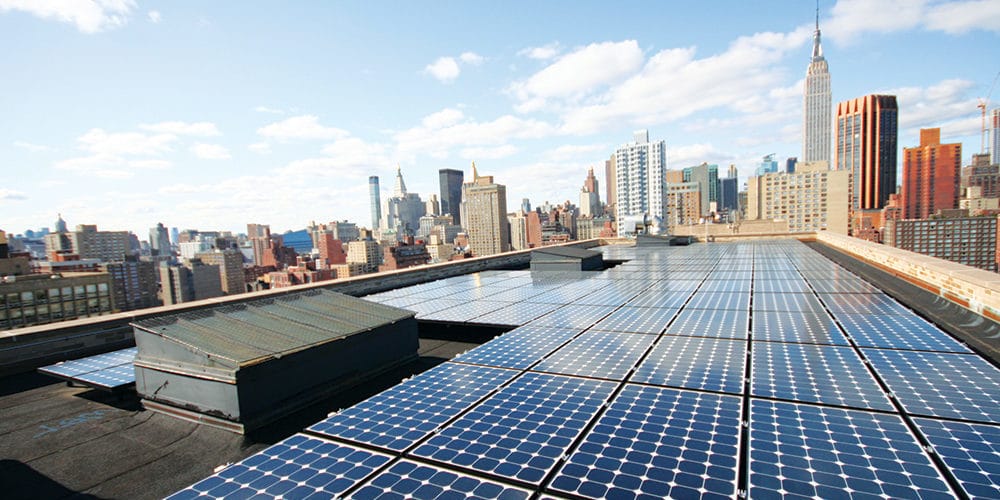The Empire State has grand green ambitions – 100% clean energy by 2040, 6 GW of of distributed solar, many more GW of utility solar, 3 GW of energy storage, and 9 GW of offshore wind by 2035. However, its compensation methods for distributed renewable energy has led to investment fall offs (73% less in Q1’18 versus Q1’17), and driven multiple attempts (1 and 2 of a few) to repair a program that was originally massively oversubscribed.
With this, per an analysis by the Natural Resource Defense Council (NDRC), the New York state Public Service Commission (PSC) has issued an order, In the Matter of the Value of Distributed Energy Resources (VDER), an Order Regarding Value Stack Compensation (pdf), that aims to help increase the ability of solar power projects in New York to get financing.
From the document, specifically, the order includes the following:
- Demand reduction value (DRV) calculation changes to reflect performance during a larger set of hours and to lock-in the value for ten years
- A continuation of the locational system relief value (LSRV), modified to compensate projects for performance during utility calls
- Expansion of Phase One Net Energy Metering (NEM) eligibility for certain additional projects under 750 kW
- Establishment of the Community Credit for certain community distribute generation (CDG) projects in the New York State Electric & Gas Corporation (NYSEG), Niagara Mohawk Power Corporation d/b/a National Grid (National Grid), Rochester Gas and Electric Corporation (RG&E), and Consolidated Edison Company of New York, Inc. (Con Edison) territories as a replacement for the Market Transition Credit (MTC).
- A provision of an upfront incentive as a market transition credit (MTC) replacement, the Community Adder, for new CDG projects in the Central Hudson Gas & Electric Corporation (Central Hudson) and Orange and Rockland Utilities, Inc. (O&R) territories
- Modification of the Alternative 1 Capacity Value calculation to reflect published New York Independent System Operator, Inc. (NYISO) monthly prices and solar photovoltaic (PV) load curves
- Modification to the Alternative 2 Capacity Value calculation to better reflect actual peak hours.
The NDRC noted three main benefits from the structures put forth above. The first is that upstate community solar would get a new credit system to better recognize the value of solar, as well these plants would be allowed to have anchor tenants. This increase in compensation is a quite obvious benefit, while the allowance of an anchor tenant would increase the credit profile of the off-takers and lower finance costs.
The second tweak recognizes the DRV and continues the LSRV. The demand reduction value was made more predictable, allowing for greater capture of the value by project owners. The location system relief value which recognizes that solar+storage can relieve congested networks was allowed to continue, which will incentivize the placement of solar and solar+storage near these congested areas.
Regarding DRV, the document noted:
Staff proposes a new DRV methodology where the total $/kW year would be assigned a $/kWh number to the peak summer hours of 1:00 PM to 6:00 PM on non-holiday weekdays from June 24 through August 31. This methodology will result in DRV compensation being spread over either 240 or 245 hours each year, which represents the summer hours that are the most likely to be candidates for the peak summer load hour. This change would increase predictability for developers by providing advanced knowledge of the specific hours and, as it spreads compensation over many more hours than the current 10-hour methodology, would substantially reduce uncertainty resulting from factors like weather.
The utility specific compensations for DRV and LSRV were noted in Appendix A of the pdf above.
The third change highlighted by the NDRC were that the Phase One NEM program was expanded to include commercial customers under 750 kWac for systems installed before the end of 2019.
This content is protected by copyright and may not be reused. If you want to cooperate with us and would like to reuse some of our content, please contact: editors@pv-magazine.com.








By submitting this form you agree to pv magazine using your data for the purposes of publishing your comment.
Your personal data will only be disclosed or otherwise transmitted to third parties for the purposes of spam filtering or if this is necessary for technical maintenance of the website. Any other transfer to third parties will not take place unless this is justified on the basis of applicable data protection regulations or if pv magazine is legally obliged to do so.
You may revoke this consent at any time with effect for the future, in which case your personal data will be deleted immediately. Otherwise, your data will be deleted if pv magazine has processed your request or the purpose of data storage is fulfilled.
Further information on data privacy can be found in our Data Protection Policy.